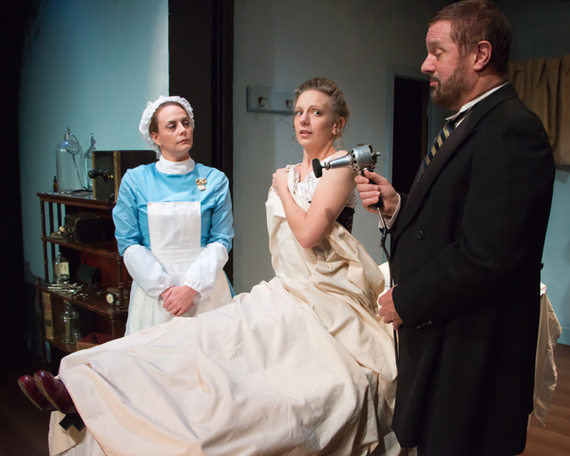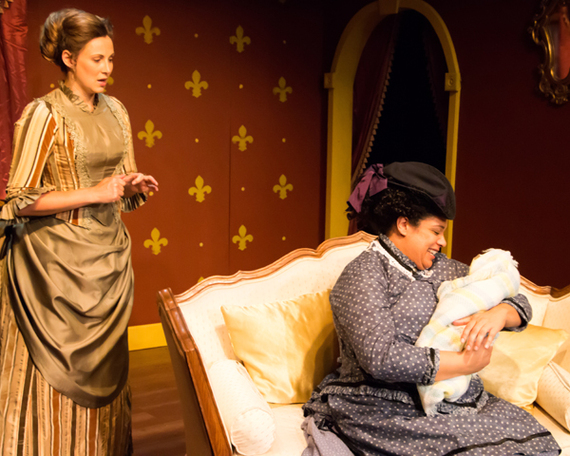A playwright sets her story against a historical or otherwise significant backdrop to provide verisimilitude, credibility, and context. Sometimes the backdrop is as interesting as the story. That's the case with Sarah Ruhl's In the Next Room or The Vibrator Play. Directed by Robert Craig for the Long Beach Playhouse Studio Theatre, the production is moving and outrageous. It presents a classic tale of a wife who feels under loved and unappreciated. It also shows how electrical stimulators that achieved hysterical paroxysms over time became vibrators that enhanced orgasms.
The acting is very good. Craig's set up and resolution, especially the final moment when the naked protagonists fling open the door against a frigid winter's eve to celebrate their newly kindled warmth, is fantastic. Andrew Vonderschmitt's set establishes the living space and the doctor's operating theater. The context of the story, though, makes it memorable.
Ruhl sets the play at the dawn of the practical use of electricity. The ability of a newfangled lamp to light up a room with the flick of a switch is noted if not celebrated. She also sets the play at a time when hysteria, particularly in women, became a convenient diagnosis of a range of symptoms. Like ADD in teenagers today. The marriage of technology and psychology led to the invention of the electric stimulator. This tool proved to be an effective treatment for this disorder. Nowadays we call these things vibrators. You can find them in as many places (including the Studio Theatre's concession stand) and colors as a roll of Life Savers candy.
From what we see and hear on stage, early vibrators were, um, primitive. There was nothing in the least erotic about them. The one for women looked like a car buffer. It came with an electric cord. The one for men, yes, there was one for men, was operated with a foot pedal, like a sewing machine. Both sounded like dental drills. Despite their appearance and sounds, they worked. Boy did they work.
Craig's direction balances arousal and emotional intimacy. Calling it The Vibrator Play teases you into thinking it's only about sex toys. It's not. Calling it In The Next Room better describes the story's more serious plot line. It concerns a wife, Catherine (Kate Felton). She wants to connect with her husband, Dr. Givings (Don Schlossman). She wants to do so because she's in emotional distress. She can't lactate. She feels a physical and emotional disconnection from her newborn child. She also feels a physical and emotional disconnection from her husband. On paper he's adept and fastidious, a man of science. These same traits make him unaware of the needs of his passionate wife. They hire the services of Elizabeth (Liliano Carrillo), a mother who just lost her newborn son. The plot recounts the couple's journey to connection.
The humor here is of the inadvertent sort. The characters exhibit real symptoms. They aren't meant to be funny. Just the same, they are. The actors' challenges are formidable. They have to be serious about their problems. Their treatment has to arouse them. And they must not know it's coming. Sabrina Daldry (Sophie Mura), Dr. Givings' patient is, to borrow a book title by C.S. Lewis, surprised by joy. So is Scott T. Finn's (Leo Irving), an artist who treats love like a business transaction. The titillation between Annie (Stephanie Schulz), Dr. Giving's assistant, and Sabrina shows how, in certain relationship configurations, men are optional.
Schlossman's Dr. Givings is hilarious. He has no doubt about the effectiveness of his method. He's also oblivious to the effect he has on Sabrina and Irving. His straight-faced definition of the obstruction the electric stimulator clears from the womb is classic. He might as well describe how to clear a clogged sink drain.
Because it's Catherine's story, though, we watch her growth with interest. Woodruff is pitch perfect. She nails her neediness for the physical attention of her husband and child as well as her frustrated attempt to hit on Irving. She's funny when she, um, self-medicates. And she's jealous at what goes go in the next room.
Ruhl's story resonates on many levels. It shows you can have a committed if quasi-platonic relationship with your spouse. It shows that you can have shallow, bought love with a stranger. Both sorts prove unsatisfactory. The best love, as shown in the production's final scene, is love that combines commitment and intimacy. All of which confirms that that love and marriage go together like a horse and carriage. Indeed, you can't have one without the other.
Performances are 8pm, Friday and Saturday, 2pm Sunday. The play runs until May 31. Tickets are $27. The Playhouse is located at 5021 E. Anaheim Street, Long Beach, CA 90802. For information call (562) 494-1014 or visit lbplayhouse.org.





